The content of the article
The horse chestnut tree can be seen long before approaching it - it is so sprawling and deciduous. Chestnut is widespread in central Russia - trees can be found in almost any forest park zone, grove, and nearby water bodies. The origin of the name "Horse" is not so clear. According to one version, horse chestnut was called only because it served as feed for horses. Another version claims that people gave a similar name to a chestnut to distinguish fruits from another, edible chestnut. Still others claim that the name chestnut owes its sparkling and rich brown color, which resembles the side of a bay horse.
Be that as it may, horse chestnut has firmly entered our lives; we often see chestnut trees and fruits. But many of us do not even realize how chestnut can be useful. From it they prepare tinctures and decoctions, make lotions and compresses, get rid of various ailments. Today we’ll talk about the healing properties and contraindications of horse chestnut.
Horse chestnut has a rich composition. It contains vitamin A, B, C and K, organic acids, coumarin, fats, starch, flavonoids, pectin, tannins, calcium, iron, chromium, iodine. All useful substances of chestnut are dispersed throughout the tree - not only are used in the treatment fruits themselves, but also seeds, tree bark, leaves, inflorescences, etc. To affect each human organ, different parts of the tree are used.
How to collect raw materials for medicine
Horse chestnut is one of the most powerful, but at the same time contradictory fruits. If you collect the medicinal raw materials correctly, it can relieve many serious health problems, no worse than expensive medicines. If you do this illiterate, the medicine may be useless or even turn out to be poison.
To collect the fruits, bark, leaves and inflorescences of horse chestnut need away from the city, highways and large settlements. A tree that grows in the forest, in the mountains, away from roads and industrial plants is best suited. The first step is to collect inflorescences when the chestnut blossoms in May. Flowers must be picked, laid out in direct sunlight and dried in a ventilated and warm place for a couple of days. Store in a canvas bag. The bark is also collected in the spring, when the first juices begin to collect under it. It is better to cut the bark from young branches, and then carefully dry it in the sun. The bark is stored for no more than a year, then it gradually loses its useful properties. Leaves can be collected at almost any time - from the appearance of young leaves to the yellowing. But the fruits are only ripe - as soon as they begin to fall to the ground. Green unripe chestnut fruits can be dangerous.
Useful properties and application of horse chestnut
Horse chestnut has many diverse properties. When used correctly, it removes excess water from the body, anesthetizes, stops and thins the blood, lowers the temperature, and disinfects wounds. From chestnut, you can prepare many useful medicines that will relieve various diseases.
- Phlebeurysm. Most often, chestnuts are used to prepare a medicine against this disease. A decoction of fruits and inflorescences perfectly dilutes the blood, protects against blood clots, increases the elasticity of blood vessels.Thanks to this, the veins begin to work better, the blood in the legs does not stagnate. With regular use of horse chestnut medication, you can get rid of spider veins and significantly improve the condition of the veins. In the fight against varicose veins, fresh inflorescence juice is used, a decoction of chopped chestnut fruits - both externally in the form of lotions and inside to thin the blood.
- Antiseptic properties. Since chestnut is a powerful bactericidal plant, antiseptic decoctions are prepared from its parts. Fruits and leaves of a chestnut are best suited for such solutions. They need to pour boiling water and let it brew for about two hours. Then the broth needs to be filtered and used to treat wounds, abrasions, ulcers, boils. The solution can rinse the mouth with diseases of the ENT organs. Pure broth can be dripped into the ear and even into the eyes to get rid of inflammation. Stomatitis, gingivitis - all this can be cured with a decoction of horse chestnut.
- Sinusitis Horse chestnut has one remarkable property - it perfectly pulls out stagnant mucus and pus. And this is so necessary with sinusitis. From young chestnuts, you need to cut out small turundochki the size of a nostril in the form of peanuts. Soak the cut figures in honey and plug both nostrils. After a while, the patient will begin to sneeze heavily, the entire contents of the maxillary sinuses will begin to come out. Do this procedure once a day. After 3-4 days, the patient's condition will improve significantly, and after a week sinusitis will be completely cured.
- Cough. Horse chestnut has a great effect on the respiratory system. It gently dilutes sputum, brings it out, suppresses and soothes a dry barking cough. Used in the fight against tracheitis, bronchitis, whooping cough and even pneumonia. To do this, you need to take a decoction of fruit or chestnut bark three times a day three times a day. A chestnut decoction can also be used as an inhalation. And the chest can be smeared with chestnut ointment. The fruits for the preparation of ointments need to be chopped, mixed with camphor oil and pork fat. Before bed, lubricate the sternum with the prepared composition - this will help to warm up and the cough will recede. A similar ointment is also very effective against neuralgia.
- Digestive organs. Horse chestnut broth is effective for diarrhea and various problems with the removal of bile. It is used to treat the liver and pancreas.
- For muscles and joints. Horse chestnut perfectly warms and relaxes muscles and joints. It is effective for rheumatism, arthritis, various injuries.
- For women's health. Since chestnut has a hemostatic effect, medications based on it allow you to quickly deal with intrauterine bleeding. A few centuries ago, a chestnut decoction was necessarily given to women after childbirth to protect her from severe bleeding. Chestnut perfectly relieves inflammation, so it can be used for external use - to do vaginal douching, etc. Horse chestnut is very effective in mastopathy - tincture and decoction eliminate inflammation, resolve the tumor, normalize hormonal levels, restore blood circulation and outflow of lymphoid fluid in the mammary glands. With mastopathy, horse chestnut-based medications must be taken both internally and externally.
- For men's health. Horse chestnut is also beneficial for men's health. Its regular consumption can protect the strong half of humanity from varicocele disease - varicose veins of the spermatic cord and testicles. In addition, horse chestnut suppresses inflammation of the prostate gland, stops the increase in prostate adenoma.
The use of horse chestnut is very, very diverse. Even in ancient times, it was noticed that crushed chestnut powder has a calming effect. If you add it to milk or tea with honey, the dream will be strong, long and fruitful.Regular consumption of chestnut in small quantities will allow you to improve performance, concentrate, less get nervous and distracted.
In the 18th century, chestnut tincture was used in the fight against malaria and dysentery. Chestnut perfectly stops diarrhea, relieves inflammation, suppresses a colony of pathogens. Moreover, a decoction of chestnut leaves perfectly relieves of fever. Already in those days, the beneficial properties of chestnut against varicose veins were known, open trophic ulcers were sprinkled with ground chestnut - they healed much faster. Patients with gout made baths with a decoction or tincture of chestnut - this made it possible to quickly and effectively get rid of the symptoms of the disease.
Today, pharmaceutical companies present to the consumer a finished and refined horse chestnut product in the form of ointments, tablets, and even an injection. As a rule, all of them are indicated for use in diseases of veins, blood vessels, thrombophlebitis, etc. The use of chestnut is also effective for hemorrhoids - a complex (internal and local) treatment is prescribed.
Horse chestnut tincture
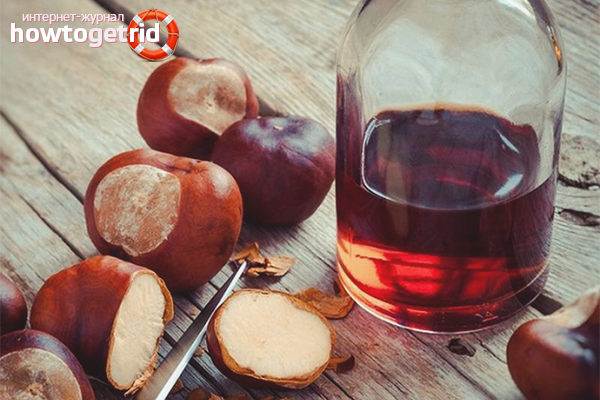
If you want to get a quality medicine that will be stored for a long time and will always be ready at your fingertips, prepare a tincture from the peel of the chestnut fruit. Chestnuts need to be cleaned and the peel put in a dark glass bottle. Fill with raw materials to the top, and then pour alcohol or vodka. Keep at least two weeks in a dark and cool place. Shake the bottle periodically to make the tincture more saturated. After the specified time, the composition must be filtered and transferred to the refrigerator. Such tincture is stored for about a year. It is much more concentrated than a decoction or juice of flowers. In case of varicose veins, thrombophlebitis, vascular diseases and hemorrhoids, take 10 drops of water in the morning and evening.
Horse chestnut for hair and skin
Chestnut has taken its rightful place in cosmetology. It is part of many creams, gels and shampoos. Horse chestnut masks and shampoos make hair strong, strong, shiny and supple. The shampoo is quite light, quickly rinsed, promotes accelerated hair growth. Horse chestnut creams are also very popular. The medicine favorably affects capillaries and blood vessels, which allows you to get rid of spider veins, hematomas and dark circles under the eyes. The absorbable effect of chestnut is used in the fight against cellulite - it perfectly removes fluid from lymphoid tissues. Creams and masks based on horse chestnut rejuvenate and tone the skin, make it firmer and more elastic, with constant use, the oval of the face is tightened. Chestnut has bactericidal properties, therefore it is effectively used in the fight against acne, and even fungal infections of the scalp. It perfectly eliminates dandruff and protects against hair loss.
Contraindications
Many people ask, in what form can a chestnut be eaten? In no - horse chestnut is not eaten. Eat another type of chestnut - edible. Besides the fact that horse chestnut is bitter enough, it can even be poisonous. You can use only medicine prepared on its basis - tincture, extract, broth, ointment, etc. Be treated with chestnut, be healthy and beautiful!
Video: how to make horse chestnut tincture

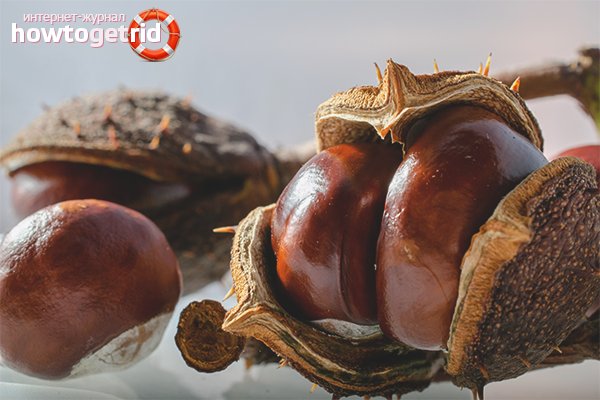


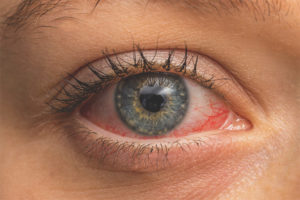


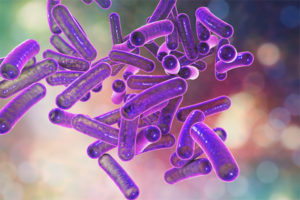
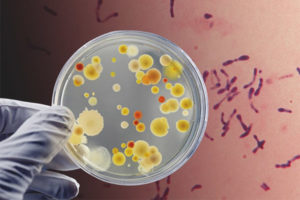
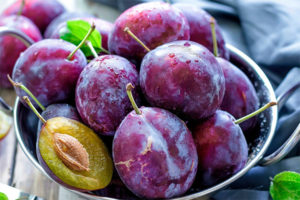
Submit